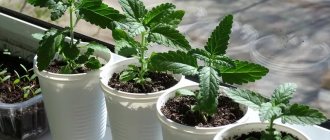Marigolds are an unpretentious plant that not only decorates the garden, but is also able to repel some pests. By the way, what kind of pests you can find out from the article on our website - mixed plantings of garden crops. And many, knowing the beneficial qualities of these flowers, wonder when and how to sow marigolds? Which method is better, seedlings or non-seedlings? How to grow marigolds in one or another region of our vastness? You will find answers to all these questions in the article on our website, when and how to grow marigold seedlings with step-by-step instructions.
When and how to grow marigold seedlings basic information
As already mentioned, marigolds repel some pests. They are also good for the soil. For example, if you cut off the top parts of the Chernobrovets in the fall and spread them out on beds prepared for spring sowing, then as they decompose, various essential oils will get into the soil. Which in turn will repel various pathogens: fungi, viruses, bacteria.
And the main question that many ask is how best to grow marigolds, in what way. The fact is that seeds do not germinate in all soils; they also need a certain climate, and so on. And in order not to take risks, it is recommended to grow marigold planting material. Moreover, seedlings are already more unpretentious to both soil and climate.
Main problems when growing
- lack of moisture. Because of this, the flowers will be small in diameter and the seeds will be poor;
- stagnation of water in the beds. This can cause the root system to rot;
- lack of light and heat. The inflorescences will develop poorly, and the green part will not be lush;
- presence of parasites. As a preventive measure, it is worth washing the bushes with water once a week and, if necessary, using pesticides.
- strong growth. As soon as you notice that there is a lot of foliage, be sure to trim it with pruning shears.
At what time in which regions and how are marigolds grown?
Any flower in the garden is primarily a symbol of summer. Roses, tulips, lush peonies, and of course marigolds. Which, like the bright yellow sun itself, attract us with its beauty, its lush flowers.
If you stand next to a flowerbed of these wonderful flowers, you can hear the buzzing of bees, which in considerable numbers are working on each petal, collecting nectar. But a shaggy bumblebee landed on the top of a young marigold, causing the flower to bend slightly under its weight.
It's all very beautiful. So let's answer our main questions.
In which regions and at what time are marigolds grown without seedlings?
There is such a variety of marigolds, it is called rejected low-growing. This variety is not at all afraid of open ground, and therefore they can be grown from seed immediately in a permanent place. In the south of the country they are sown in April, and in regions with a cool climate throughout May.
In areas such as the Volgograd region, Krasnodar region, Rostov region, Stavropol region, seeds can be immediately sown in the ground.
My mother always grows marigolds. And often leaves dried out plants in the flowerbed. They are covered with snow, they endure severe frosts, and in the spring they drop their seeds and grow again. So, if the weather and soil permit, then marigolds can be grown without seedlings. By the way, such flowers bloom longer.
Helpful advice. If you still decide to grow marigolds without seedlings, but are worried that the weather may change for the worse. Experienced gardeners recommend covering crops with agrofibre or film. This way you will save your crops in case of worsening weather conditions.
When to plant marigold seedlings in the middle zone and other regions
In different regions, due to the individual climate, sowing and planting of seedlings shifts. For example, in Moscow, in the Moscow region and in the middle zone, it is better to sow marigold seeds for seedlings in the second half of March. Replant in open ground in these regions in the first and early second ten days of May.
For regions where the weather is characterized by dampness and low temperatures: Siberia, Leningrad region, the Urals, in these areas they begin sowing at the end of March, at the beginning of April.
In order not to make a mistake with planting, it is good to know the growth period of seedlings. For example, marigolds develop from the moment of germination to planting for 1.5 - 2 months. And if you know the climate in your region, then calculating when to sow seedlings will not be difficult.
Spring planting rules and technology
The basic rules for sowing marigolds do not differ from the basic rules for planting flowering annuals by seed:
- The area allocated for flowers should be evenly illuminated by the sun and protected from strong gusts of wind and drafts.
- If the flowerbed is located in a low area and water collects in it, it is necessary to take care of drainage layering.
- Before planting, the material and soil must be prepared.
- Plantings should not be too dense. Intertwined plants interfere with each other, creating oxygen deficiency.
- Low-growing flowers should be planted along the edge, along the border, medium-sized ones in the middle, and tall ones along the back wall of the flowerbed.
And, of course, we should not forget about systematically loosening the soil and controlling weeds. The latter not only spoil the appearance of the flowerbed, but also depress the flowers, depriving them of the lion's share of useful substances extracted from the soil, as well as light and air.
Pre-sowing preparation
Pre-sowing seed preparation involves the following actions:
- Soak. It continues for 3-4 days until the seeds hatch.
- Disinfection.
- Treatment with growth stimulants.
Not only the seeds, but also the soil are prepared for planting. It should be dug up, fed with dry mineral fertilizers, and it is highly advisable to disinfect it.
Landing technology
The direct process of planting flowers in exhaust gas consists of the following stages:
- Shallow (about 2 cm) furrows or holes are made.
- These places are watered abundantly.
- Then seeds are sown in them.
- The top of the marigolds is covered with a thin layer of soil (about 1 cm).
- The planting site is covered with film to create a greenhouse effect.
The film is removed when friendly shoots appear. Seedlings are watered moderately. They do not need fertilizer at this stage of development.
How to sow marigold seeds for seedlings
It is described above in which regions and at what time it is possible to sow marigold seeds using the seedless method and the seedling method.
Kupena flower
Many novice gardeners do not want to take risks and experiment with sowing seeds in open ground, and for them there is a simple solution to grow seedlings of these beautiful flowers.
To grow seedlings, you can use a simple box, which you can make yourself from plywood, or buy a special container at a country store.
The box is filled with soil from the garden or you can purchase special soil from the same store where you buy the container. Next, the soil is shed generously with warm water and allowed to soak for 1 – 2 hours. After this, they proceed directly to sowing the seeds. They are scattered or randomly, but better in rows, at a distance of 2 - 2.5 centimeters from each other. This distance is maintained both between seeds and between rows.
The seeds are sprinkled with soil in a layer of no more than one centimeter. Next, the container is covered with film or glass. To create a microclimate inside the container.
Planting time for marigolds according to the lunar calendar 2022
Another tool for determining the correct dates is the Lunar Calendar (LC). According to him, it is recommended to plant marigolds on the waxing moon. Constellations should also be taken into account.
Thus, Cancer, Taurus and Pisces are considered the best helpers. On the contrary, Aries and Leo do not contribute to the development and growth of flowers.
The best days for planting
According to the LC for 2022, the most successful plantings will be those made on the following days:
| Month | Dates | |||||||||||
| April | 2 | 3 | 4 | 5 | 6 | 25 | 26 | 27 | 28 | 29 | ||
| May | 1 | 2 | 3 | 4 | 5 | 24 | 25 | 26 | 27 | 28 | 29 | 31 |
| June | 1 | 2 | 3 | 23 | 24 | 25 | 26 | 27 | 29 | 30 | ||
At this time, the Moon promotes the accelerated movement of internal juices in plant organisms, which has a positive effect on their growth and development.
Bad days
You should not plan planting work on such days:
| Month | Dates | ||||||||
| April | 1 | 7 | 8 | 9 | 15 | 22 | 23 | 24 | 30 |
| May | 6 | 7 | 8 | 14 | 21 | 22 | 23 | 30 | |
| June | 4 | 5 | 6 | 13 | 20 | 21 | 28 | ||
Even if the seeds sprout, the resulting plants will be stunted and sickly. You definitely shouldn’t expect dense bushes with large flowers from marigolds planted these days.
How much should you trust the lunar calendar?
LC is, rather, an additional tool for calculating landing times, despite the impressive number of its adherents. Yes, many gardeners are guided by the Moon, but the decisive factors still remain seeds (or rather, their quality) and climate.
After all, one cannot but agree that no Moon, waxing or waning, can revive moldy seeds. It will not protect prematurely planted flowers from night frosts.
Therefore, experienced gardeners proceed as follows: they select a suitable time range that matches the weather requirements of the plants, then apply it to the LC. The days that coincide will be the best landing dates.
Caring for marigold seedlings after sowing
Further in our article, when and how to grow marigold seedlings with step-by-step instructions, we will talk about caring for marigold seedlings.
After germination, the film or glass is removed and the humidity is monitored. Regular watering promotes abundant flowering in the future.
Not infrequently, marigold is bothered by spider mites; in the fight against them, it is necessary to carry out the effect of sprinkling, and the mite, which does not like high humidity, will not be present on the plant.
In addition to watering and air-drip irrigation, it is worth paying attention to additional lighting. The fact is that seedlings without additional light can become very elongated and this is very bad.
But if everything is fine with your seedlings, regular watering, good light, they begin to grow profusely in the container and become crowded. So it's time to pick
Soil preparation
As always, we buy soil for flowers in a specialized store. But if you want to get confused, then this mixture will do: two parts peat, one part compost, half a part sand. The preparation does not end there; it is still necessary to disinfect the mixture. They do this in three different ways:
- We bake in the oven for about an hour or in a double boiler for 30 minutes.
- Prepare a dark pink solution of potassium permanganate and pour it in.
- We pour a solution of fungicide purchased at the store.
Choose any method that suits you best, but steaming in an oven or steamer kills not only fungal spores, but also weed seeds.
Picking marigold seedlings in two ways
Picking will have a very beneficial effect on the further development of seedlings. Seedlings dive in the phase of formation of 2–3 true leaves. When picking, seedlings are buried down to the cotyledon leaves. This way, the transplanted seedlings will be strong and stocky.
Dive at a distance between rows of 4 - 5 centimeters, between plants 2 - 3 centimeters. Let's consider two methods, in the furrows and using tweezers.
Picking marigold seedlings into furrows
To do this, you need to take a box much larger than the one containing the young seedlings. It must be at least five centimeters high. The box is filled with soil, leveled so that the surface has no depressions or depressions. This is done so that there is no stagnation or drying out of the hills.
Furrows are made in the soil, so deep that the seedlings are deepened to the cotyledon leaves. The soil around the plants is lightly squeezed.
Beautiful lilies in the garden
History of names
Thin-leaved marigolds, like other species, belong to the Asteraceae family. In Latin the flower is called Tagetes tenuifolia.
The first word in the name owes its origin to Carl Linnaeus. He named him in honor of the grandson of Jupiter, who amazed everyone with his romantic beauty and had the gift of foresight. His name was Tages. In the modern world, Tagetes, regardless of type, also continue to amaze everyone who sees them with their beauty.
The second word in the name of the flower is translated as thin-leaved.
Well, as many probably guess, they were nicknamed marigolds because the petals of their inflorescences look very velvety both in appearance and to the touch.
This type of marigold is also called Mexican. And here everything is very simple and with the popular name of the flower, unlike other marigolds, we finally hit the mark. After all, all known species of marigolds come from the American continent.
Fine-leaved marigolds have been known in cultivation only since 1795.
Thin-leaved or Mexican marigolds: description of the species
Thin-leaved Tagetes appeared in Russian gardens not so long ago, but its attractiveness and unpretentiousness were appreciated by flower growers. The plant is native to Central America. Thin-leaved Tagetes (lat. Tagetes tenuifolia) or Mexican is an annual herbaceous plant 20-40 cm high. The stems are branched from the very base, the shoots are strong and flexible. The leaves are narrow, up to 3 cm long. They are pinnately dissected, with serrated edges and dotted glands. Color: light green.
Information. The aroma of Mexican marigolds differs from the aroma emitted by other members of this genus. It is not intrusive, soft, and has subtle citrus notes.











